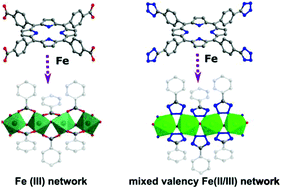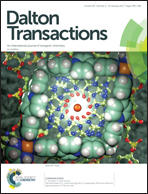Tuning the iron redox state inside a microporous porphyrinic metal organic framework†
Abstract
Two new 3D porphyrin-based metal organic frameworks were obtained by solvothermally reacting iron(III) chloride, a free base (5,10,15,20-tetrakis[4-(2,3,4,5-tetrazolyl)phenyl]porphyrin) (H2TTPP) and either pyrazine or 1,4-diazabicyclo[2.2.2]octane (DABCO). Both MOFs displayed a 3-D open framework of the fry topology, where the inorganic building unit is a chain of corner-sharing FeN4O2 octahedra and the porphyrinic linker is metallated with iron during the reaction course, with the N-donor base bridging the iron of the porphyrinic cores. Through thorough structural and spectroscopic analyses of the pyrazine containing material the chemical formula [FeIIpzTTP(FeII1−xDMF1−xFeIIIxOHx)]n was inferred (x ≥ 0.25). Whereas the already reported carboxylate analogue is built up from a pure iron(III) inorganic chain, here spectroscopic and structural studies evidenced a mixed valence iron(II/III) state, evidencing that, in agreement with the HSAB theory, the substitution of a carboxylate function by a tetrazolate one allows redox tuning. Finally, both materials feature one-dimensional channels of ca. 8 × 12 Å within the structures with permanent microporosity.


 Please wait while we load your content...
Please wait while we load your content...